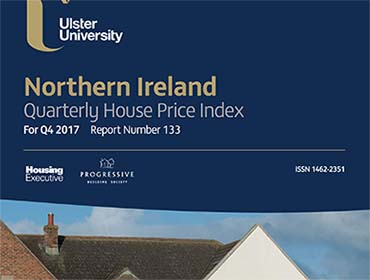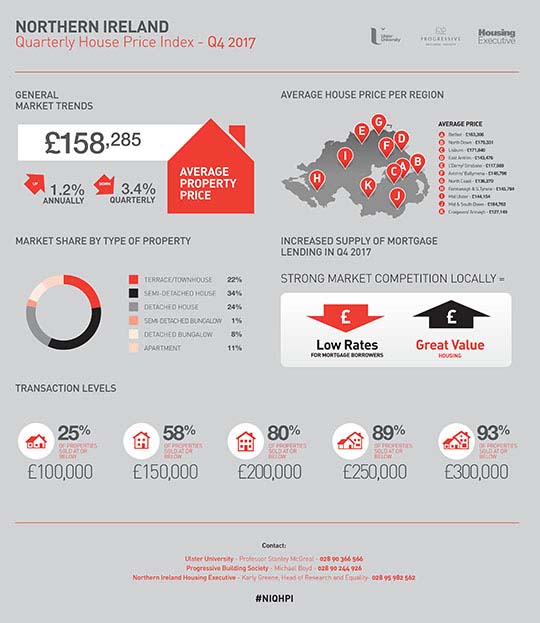The Northern Ireland housing market has experienced a relatively gradual pace of nominal price growth in Q4 2017, reflecting a sustainable level of transactions, according to Ulster University’s latest Quarterly House Price Index report.
In Mid and South Down, the overall average price (£164,763) is up significantly by 8.8% and 9.4% over the annual and quarterly time periods respectively benefiting from strong price growth during the fourth quarter of 2017, the latter being influenced by a higher representation of detached houses in the sample for fourth quarter.
 Furthermore, analysis by property type highlights considerable variability in performance with terrace/townhouses (£98,991), though still commanding a high average price, dropping back by circa 3%. Semi-detached houses (£128,778) have a largely unchanged average price, down slightly by 1.3% over the quarter. In contrast, detached houses (£241,151) have a considerably strengthened average price up by over 15% annually and by 9% for the quarter. Likewise, the relatively small apartment sector has benefitted from a number of sales of newly built property which has boosted the average price level to £131,478.
Furthermore, analysis by property type highlights considerable variability in performance with terrace/townhouses (£98,991), though still commanding a high average price, dropping back by circa 3%. Semi-detached houses (£128,778) have a largely unchanged average price, down slightly by 1.3% over the quarter. In contrast, detached houses (£241,151) have a considerably strengthened average price up by over 15% annually and by 9% for the quarter. Likewise, the relatively small apartment sector has benefitted from a number of sales of newly built property which has boosted the average price level to £131,478.
Ulster University’s research is produced in partnership with the Northern Ireland Housing Executive and Progressive Building Society.
Analysing the performance of the housing market during October, November and December 2017, the overall average price for the fourth quarter of 2017 was £158,285, representing an annual increase of 5% relative to the final quarter of 2016.
However, allowing for differences in sample mix by property type, the weighted increase over the year and the preferred measure for these surveys is a more modest 1.2%.
The distribution of sale prices is similar to the previous quarter with 25% of sales at or below £100,000. The percentage of properties sold at or below £150,000 has declined to 58% of transactions compared with 60% in the previous quarter.
For the higher price bands, 80% of transactions are at or below £200,000, 89% of properties sold at or below £250,000 and 93% at or below £300,000. The analysis by price band is indicative of a still highly affordable housing market in Northern Ireland.
The market share by property type remains broadly consistent with previous reports. Semi-detached houses again dominate (34%) and terrace/townhouses take 22% of transactions.
The volume of transactions in the survey is 2,219.
Lead researcher, Professor Stanley McGreal from Ulster University said:
“In terms of estate agent perceptions, there is a perspective that 2017 had been largely a good year for the local housing market, with property turning over at a reasonable rate and price levels sustained. This has been translated into a feeling of short-term confidence among those in the industry concerning prospects for 2018.
“However, looking at the market with a medium-term perspective, there is still considerable uncertainty as to what impact, if any, Brexit will bring and whether the likely transition arrangements will soften or defer any such impact down the line.”
Michael Boyd, Progressive Deputy Chief Executive and Finance Director added: “The local housing market’s sustainable growth in 2017 reflects the affordability that prevails both in urban and regional locations.
“However, this is set against the backdrop of a relatively slow-moving year for house price growth of 1.2%. Following a strong uplift in Q3 2017 of 8.3%, Q4 saw a decline in house price sales of 3.4%. This is nevertheless compatible with seasonal trends and the overall annual picture reflects a steady and confident market last year.
“That said there are a number of factors which will influence the market’s overall performance in 2018. One of the most pressing issues remains the long-term impact of Brexit with early clarity needed for businesses on the transition period and the long-term relationship with the EU.”
Karly Greene, Head of Research and Equality at the Housing Executive, said: “The housing market trends of the last year look likely to carry on into 2018, with a healthy level of transactions, a low but sustainable level of house price growth and – importantly – continued availability of relatively affordable options for first time buyers and newly forming households.”
The full report can be found at:
goo.gl/JujR1 (note: the link will not direct to the Q2 report until Friday 17 November 2017). Refer to the copy of the report appended.
***
Market share by type of property:
| Market sector | Market Share |
| Terrace/townhouse | 22% |
| Semi-detached house | 34% |
| Detached house | 24% |
| Semi-detached bungalow | 1% |
| Detached bungalow | 8% |
| Apartment | 11% |
Performance by Property Type
| Market sector | Annual % Change | Quarterly % Change | Average Price Q4 2017 | Average Price
Q1-Q4 2017 |
| Terrace/townhouse | 0.4% | -6.7% | £100,947 | £103,196 |
| Semi-detached house | 5.9% | -0.2% | £148,572 | £145,680 |
| Detached house | -0.8% | -5.2% | £237,191 | £239,436 |
| Semi-detached bungalow | 3.1% | -2.6% | £117,090 | £116,492 |
| Detached bungalow | -1.5% | -2.4% | £176,963 | £177,296 |
| Apartment | -2.2% | -2.7% | £120,540 | £120,448 |
Performance by Region
| Location | Average Price
2017 Q4 |
Average Price
2017 Q1-Q4 |
| Northern Ireland – All | £158,285 | £155,049 |
| Belfast-All | £163,306 | £162,474 |
| North Belfast | £114,846 | £108,734 |
| South Belfast | £210,206 | £211,382 |
| East Belfast | £195,219 | £179,582 |
| West Belfast | £117,504 | £124,515 |
| North Down | £179,332 | £177,222 |
| Lisburn | £171,840 | £177,203 |
| East Antrim | £143,476 | £134,886 |
| L’Derry/Strabane | £117,989 | £119,226 |
| Antrim Ballymena | £146,796 | £138,790 |
| Coleraine/Limavady/North Coast | £136,270 | £150,194 |
| Enniskillen/Fermanagh/S.Tyrone | £145,784 | £139,703 |
| Mid Ulster | £144,154 | £139,007 |
| Mid and South Down | £164,763 | £158,165 |
| Craigavon/Armagh | £127,149 | £131,503 |
***
About Ulster University
Ranked in the top 3 per cent of universities worldwide, Ulster University is one of the top 150 global young universities under 50. Ulster University is a modern, forward-looking institution with student experience at the very heart of everything we do. Our high-quality teaching, informed by world-leading research across key sectors, boosts the economy and has a positive impact on the lives of people around the world.
Ulster University has an international reputation for biomedical sciences research and is ranked among the top five universities in the UK in terms of research power in this area with 100 per cent of its research rated 4 star world-leading.
For more information please visit:
or follow us on Twitter @ulsteruni



























